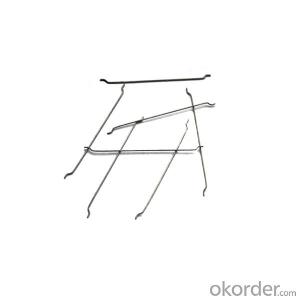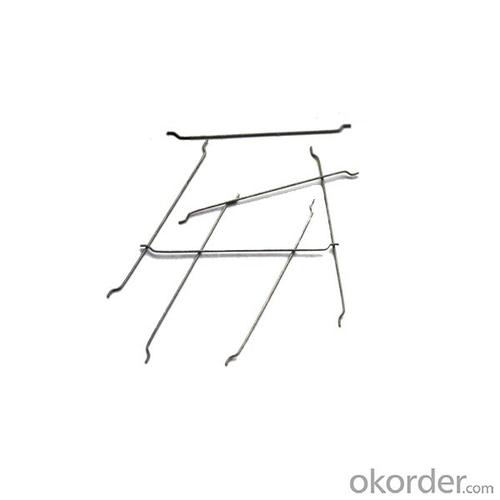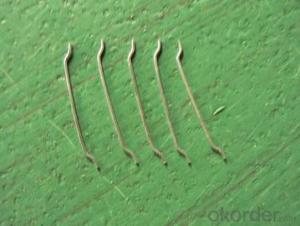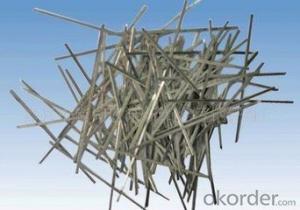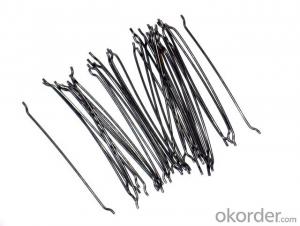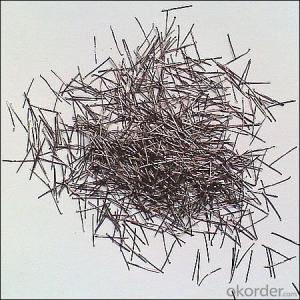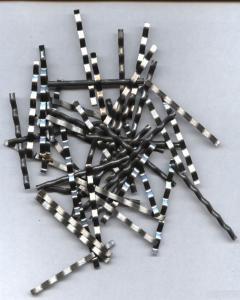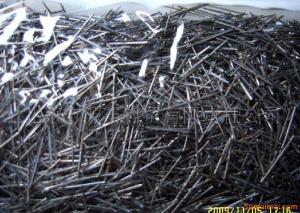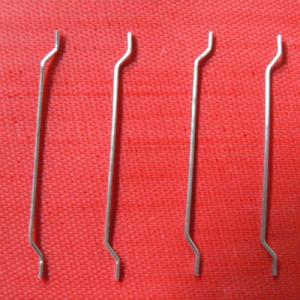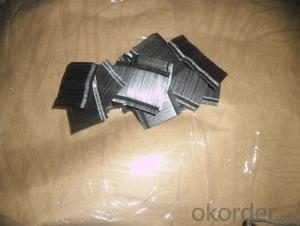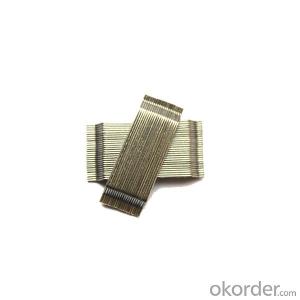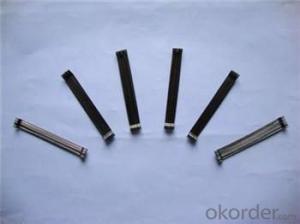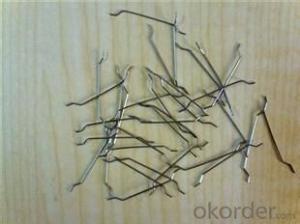Steel price per ton concrete steel fiber
- Loading Port:
- Tianjin
- Payment Terms:
- TT OR LC
- Min Order Qty:
- 1 m.t.
- Supply Capability:
- 600 m.t./month
OKorder Service Pledge
Quality Product, Order Online Tracking, Timely Delivery
OKorder Financial Service
Credit Rating, Credit Services, Credit Purchasing
You Might Also Like
Quick Details
Place of Origin: Tianjin, China (Mainland)
Model Number: 0.6
Material: Steel
Production Process: Cold drawn
Fiber Lengh: 35
Type: 1
Compressive Strength: >1200MPa
Aspect ratio: 60
Standard: ASTM A820M-11
Section Shape: Circular
Application: Concrete Reinforcement
Product Application: Industrial Floor
Packaging & Delivery
| Packaging Details: | 20 kg/Bag,50 bags/Pallet or 1,000kg/ Bulk Bag |
|---|---|
| Delivery Detail: | 1 Month |
Product Description
| Diameter | 0.60 | mm | 0.02 | in |
| Length | 35.00 | mm | 1.37 | in |
| Aspect Ratio | 58 | |||
| Tensile strength | 1200 MPa | |||
| Type | Cold drawn Steel Fiber | |||
| End | Hooked-end Steel Fiber | |||
| Glued/Loose | Glued Steel Fiber | |||
| Bending Angle | 45°(min.30°) | |||
| Usage & Performance | Floor:Trafficked areas and Industrial floors | |||
| Shotcrete :Slope stabilization and Final lining | ||||
| Precast concrete:Pipe and Railway sleepers | ||||
| Packing | Standard Export Pallet Packing | Bag Packing | 20 kg/Bag,50 bags/Pallet | |
| Bulk Packing | 1,000kg/ Bulk Bag | |||
| Loading Quantity | 20’GP | 20-25 Tonne/Tonnes | ||
| 40’GP | 25-27 Tonne/Tonnes | |||
| 40’HQ | 25-27 Tonne/Tonnes | |||
| MOQ | 1 kg for trial order | |||
| Supply Ability | 10,000 Tonne/Tonnes per Year | |||
| Payment Terms | T/T or L/C at sight | |||
| Delivery Time | Within 15 days after receiving deposit or original L/C at sight | |||
| Certification | ISO9001:2000, CE, | |||
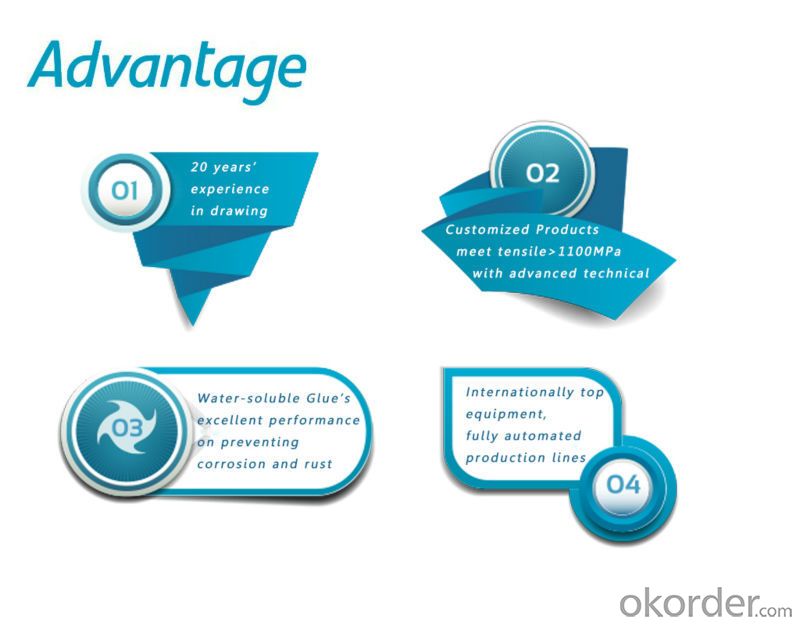
| Product | Diameter | Length mm/in | Aspect Ratio | Type | Packing |
| G-6030 | 0.5 mm (0.0197 in) | 30 mm (1.1811 in) | 60 | Glued | 20 kg/Bag, or 1,000kg/ Bulk Bag |
| G-6535 | 0.55 mm (0.0217 in) | 35 mm (1.3780 in) | 65 | Glued | 20 kg/Bag, or 1,000kg/ Bulk Bag |
| G-6035 | 0.6 mm (0.0236 in) | 35 mm (1.3780 in) | 60 | Glued | 20 kg/Bag, or 1,000kg/ Bulk Bag |
| G-8060 | 0.75 mm (0.0295 in) | 60 mm (2.3622 in) | 80 | Glued | 20 kg/Bag, 50 bags/Pallet |
| G-6060 | 0.9 mm (0.0354 in) | 60 mm (2.3622 in) | 60 | Glued | 20 kg/Bag, 50 bags/Pallet |
| G-6030 | 0.5 mm (0.0197 in) | 30 mm (1.1811 in) | 60 | Loose | 20 kg/Bag, or 1,000kg/ Bulk Bag |
| G-6535 | 0.55 mm (0.0217 in) | 35 mm (1.3780 in) | 65 | Loose | 20 kg/Bag, or 1,000kg/ Bulk Bag |
| G-6035 | 0.6 mm (0.0236 in) | 35 mm (1.3780 in) | 60 | Loose | 20 kg/Bag, or 1,000kg/ Bulk Bag |
| G-8060 | 0.75 mm (0.0295 in) | 60 mm (2.3622 in) | 80 | Loose | 20 kg/Bag, 50 bags/Pallet |
| G-6060 | 0.9 mm (0.0354 in) | 60 mm (2.3622 in) | 60 | Loose | 20 kg/Bag, 50 bags/Pallet |
- Q: Can melt extract stainless steel fiber be used in shotcrete tunnel boring machine applications?
- Yes, melt extract stainless steel fiber can be used in shotcrete tunnel boring machine applications. Shotcrete is a method of applying concrete or mortar using a high-pressure hose, and the addition of stainless steel fiber can enhance the mechanical properties and durability of the shotcrete. The melt extract stainless steel fiber is made from stainless steel through a melting and extraction process, resulting in a high-strength fiber with excellent corrosion resistance. These properties make it suitable for use in tunnel boring machine applications where the shotcrete needs to withstand high pressures, vibrations, and potential exposure to moisture or chemicals. Additionally, the stainless steel fiber can improve the flexural and tensile strength of the shotcrete, reducing the risk of cracking and enhancing the overall stability and performance of the tunnel structure.
- Q: What is the effect of melt extract stainless steel fiber on the modulus of rupture of shotcrete?
- The effect of melt extract stainless steel fiber on the modulus of rupture of shotcrete is that it enhances the overall strength and durability of the shotcrete. The stainless steel fibers reinforce the shotcrete matrix, preventing cracks and improving the resistance to bending and flexural stresses. This leads to an increased modulus of rupture, making the shotcrete more resistant to cracking and improving its structural performance.
- Q: What is the effect of melt extract stainless steel fiber on the modulus of porosity of concrete?
- By incorporating melt extract stainless steel fibers into the concrete mix, the modulus of porosity is significantly impacted. The inclusion of these stainless steel fibers helps decrease the overall porosity of the material, thanks to their exceptional attributes like high tensile strength and resistance to corrosion. The inclusion of melt extract stainless steel fibers serves to enhance the strength and durability of the concrete material by filling in gaps and reducing porosity. As a result, the concrete matrix becomes denser, leading to a decreased modulus of porosity. This reduction in porosity elevates the concrete's ability to resist water absorption, chemical attacks, and freeze-thaw cycles. Moreover, the stainless steel fibers also augment the concrete's ability to resist cracks and increase its ductility. Acting as reinforcement, these fibers offer additional strength and hinder the propagation of cracks. Consequently, the modulus of elasticity is improved, which measures the material's capacity to deform under stress and regain its original shape. All in all, the incorporation of melt extract stainless steel fibers into concrete yields positive outcomes for the modulus of porosity. It not only enhances the durability, strength, and crack resistance of the concrete but also makes it a preferable choice for a range of construction applications that demand high-performance and long-lasting concrete.
- Q: Can melt extract stainless steel fiber be used in water retaining structures?
- Melt extract stainless steel fiber is indeed applicable for water retaining structures. Due to their corrosion-resistant nature and high tensile strength, stainless steel fibers are well-suited for use in structures exposed to water or other corrosive environments. These fibers have the ability to improve crack resistance, reduce permeability, and increase flexural strength, thereby enhancing the durability and performance of water retaining structures. Moreover, they play a crucial role in preventing the formation and propagation of cracks, a particularly advantageous feature for maintaining water tightness in such structures. By incorporating melt extract stainless steel fiber, the longevity and structural integrity of water retaining structures can be significantly improved.
- Q: How does melt extract stainless steel fiber improve the resistance to seismic loading in concrete?
- Melt extract stainless steel fiber is a reinforcement material that greatly enhances the ability of concrete structures to withstand seismic loading. Seismic loading refers to the stress and vibrations that buildings experience during earthquakes or other seismic events. One way in which melt extract stainless steel fiber improves the seismic resistance of concrete is by increasing its tensile strength and ductility. These fibers are extremely strong and can withstand high levels of stress and strain. When added to concrete, they act as reinforcement, bridging cracks that occur under seismic loading and preventing further propagation. Additionally, melt extract stainless steel fiber also improves the bond between concrete and other construction materials, such as reinforcing bars or steel frames. This stronger bond helps distribute seismic forces more evenly throughout the structure, reducing localized stress concentrations and improving overall stability. Another advantage of using melt extract stainless steel fiber in concrete is its ability to absorb and dissipate energy during seismic events. When the ground shakes, the fibers absorb the energy generated by seismic forces, preventing it from being transferred to the concrete. This energy absorption capability reduces stress on the concrete and enhances its ability to withstand seismic loading. Furthermore, melt extract stainless steel fiber improves the durability and longevity of concrete structures in seismic regions. It acts as a barrier against corrosion and deterioration, preventing the infiltration of moisture and harmful chemicals that can weaken the concrete over time. This enhanced durability ensures that the structure remains resilient and can withstand multiple seismic events over its lifespan. In conclusion, melt extract stainless steel fiber enhances the resistance of concrete to seismic loading by improving its tensile strength, ductility, bond strength, and energy absorption capacity. By preventing crack propagation, distributing seismic forces evenly, and increasing overall durability, this reinforcement material significantly improves the seismic resistance of concrete structures, making them safer and more resilient in earthquake-prone areas.
- Q: What is the effect of melt extract stainless steel fiber on the early-age cracking of concrete?
- The use of melt extract stainless steel fiber in concrete can have a positive effect on reducing early-age cracking. Early-age cracking in concrete occurs due to a variety of factors, including temperature changes, shrinkage, and rapid moisture loss. Stainless steel fibers, when added to the concrete mix, provide reinforcement and enhance the overall tensile strength of the concrete. This reinforcement helps to control the formation and propagation of cracks during the early stages of concrete curing. The unique properties of melt extract stainless steel fibers, such as high tensile strength, corrosion resistance, and durability, make them an excellent choice for mitigating early-age cracking. These fibers effectively distribute stress throughout the concrete matrix, limiting crack initiation and propagation. Additionally, melt extract stainless steel fibers can also help to control plastic shrinkage cracking. During the initial stages of concrete curing, rapid moisture loss can cause the surface to shrink and crack. The addition of stainless steel fibers helps to restrain this shrinkage, reducing the likelihood of early-age cracking. It is important to note that the specific effect of melt extract stainless steel fiber on early-age cracking may vary depending on factors such as fiber dosage, concrete mix design, and environmental conditions. Therefore, it is essential to conduct thorough testing and consult with experts to determine the optimal fiber dosage and application for a specific project.
- Q: Can melt extract stainless steel fiber be used in the construction of water storage tanks?
- Yes, melt extract stainless steel fiber can be used in the construction of water storage tanks. Stainless steel fibers are known for their high corrosion resistance and durability, making them suitable for use in water storage tanks where they can withstand the corrosive nature of water and provide structural reinforcement.
- Q: What is the recommended mix design when using melt extract stainless steel fiber in concrete?
- The recommended mix design when using melt extract stainless steel fiber in concrete typically involves a dosage rate of 1 to 2% by volume of concrete. This dosage rate helps to enhance the mechanical properties of the concrete, such as its tensile strength, flexural strength, and impact resistance. Additionally, it is important to use a well-graded aggregate and a water-cement ratio that is suitable for the specific application and desired performance requirements.
- Q: What are the different quality standards and certifications for melt extract stainless steel fiber?
- There are several quality standards and certifications that are relevant to melt extract stainless steel fiber. These standards ensure that the fiber meets specific criteria and requirements, ensuring its quality and performance. Some of the most common quality standards and certifications for melt extract stainless steel fiber include: 1. ISO 9001: This is an international standard for quality management systems. It ensures that the manufacturer has implemented a quality management system that consistently meets customer requirements and complies with applicable regulations. 2. ASTM International: ASTM International is a globally recognized standards development organization. They have developed several standards specifically for stainless steel fibers, such as ASTM A820 for steel fibers for fiber-reinforced concrete and ASTM A1094 for steel fibers for concrete reinforcement. 3. EN Eurocodes: The Eurocodes are a set of European standards for the design of structures. EN 14889-1 is the European standard specifically for steel fibers for concrete reinforcement. It provides requirements for the mechanical properties, dimensions, and durability of the fibers. 4. AISI: The American Iron and Steel Institute (AISI) is an association of North American steel producers. They have developed a specification for stainless steel fibers, known as AISI 304 or AISI 316, which specifies the chemical composition, mechanical properties, and other characteristics of the fiber. 5. CE Marking: CE marking is a mandatory conformity marking for certain products sold within the European Economic Area (EEA). It indicates that the product complies with the essential health, safety, and environmental requirements set out in European Union directives. 6. ICC-ES: The International Code Council Evaluation Service (ICC-ES) provides evaluation reports and certifications for building products. They have developed evaluation criteria for steel fibers used in concrete reinforcement, ensuring that they meet specific performance and safety requirements. It is important to note that the specific quality standards and certifications may vary depending on the intended application of the melt extract stainless steel fiber. It is recommended to consult the manufacturer or supplier to determine the applicable standards and certifications for a particular product.
- Q: How does melt extract stainless steel fiber improve impact resistance in concrete?
- The impact resistance of concrete is enhanced by melt extract stainless steel fiber, as it reinforces the concrete and improves its structural integrity. During the mixing process, the fibers are dispersed throughout the concrete matrix, creating a reinforcement system in the form of a three-dimensional network. When a load or impact is applied to the concrete, the stainless steel fibers help distribute the stress and absorb the energy. This action prevents cracks from propagating and reduces the chances of concrete failure. The fibers function as miniature reinforcement bars, enhancing the concrete's tensile strength and ductility. Additionally, the melt extract stainless steel fibers have a high aspect ratio, which means they are long and thin. This attribute further enhances their effectiveness in impact resistance. The fibers can bridge and connect cracks in the concrete, inhibiting their growth and preventing further damage. The impact resistance properties of the stainless steel fibers are also attributed to the stainless steel material itself. Stainless steel is renowned for its strength and durability, making it an excellent choice for reinforcing concrete. It also has exceptional corrosion resistance, ensuring the long-term performance and durability of the concrete structure. In summary, melt extract stainless steel fiber improves the impact resistance of concrete by providing additional reinforcement, distributing stress, absorbing energy, preventing crack propagation, enhancing tensile strength, and bridging cracks. Its high aspect ratio and corrosion-resistant properties further contribute to its effectiveness in enhancing the overall impact resistance of concrete structures.
Send your message to us
Steel price per ton concrete steel fiber
- Loading Port:
- Tianjin
- Payment Terms:
- TT OR LC
- Min Order Qty:
- 1 m.t.
- Supply Capability:
- 600 m.t./month
OKorder Service Pledge
Quality Product, Order Online Tracking, Timely Delivery
OKorder Financial Service
Credit Rating, Credit Services, Credit Purchasing
Similar products
Hot products
Hot Searches
Related keywords

